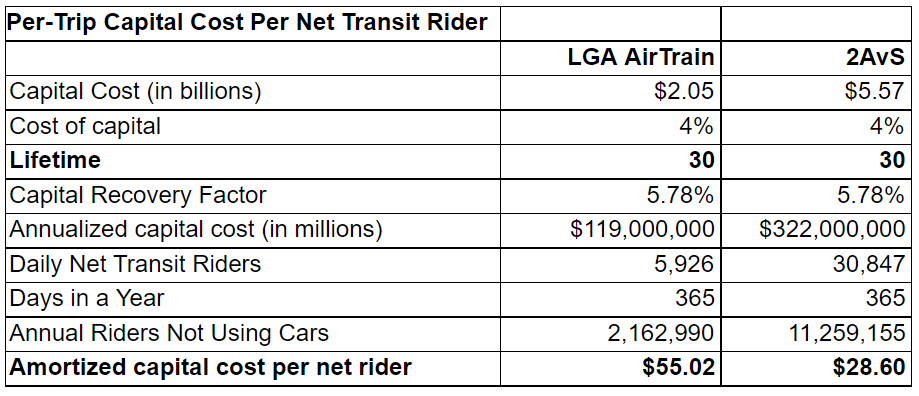However You Slice it, the LGA AirTrain Still Far More Expensive than Second Avenue Subway
Using Standard Assumption of 30-Year Operating Life, the Capital Cost Per Ride of
LGA Airtrain Transit Rider = $55.02
Second Avenue Subway Rider = $28.60
Reinvent Albany compared the capital cost of the proposed LGA Airtrain with the completed Phase 1 of the Second Avenue Subway in a September 10, 2021 report. In that report, we compared the capital cost of both projects with each project’s net daily projected transit ridership. This was an apples to apples analysis that found the AirTrain to be twice as expensive as the Second Avenue Subway.
Below, we compare capital cost over the 30-year life expectancy of the LGA Airtrain, using recommended calculations from transit economist Charles Komanoff. (See a link to the spreadsheet here.) 
Initial Capital Costs Spread Over Time Must Include Full Cost of Financing
The real financial cost of a capital project like LGA Airtrain is the upfront capital cost plus the cost of borrowing that money and paying interest and fees. The Port Authority estimates the cost of the AirTrain to be at least $2.05 billion in their Final Environmental Impact Statement. The Regional Plan Association in 2018 tallied the total capital cost of the Second Avenue Subway to be $5.57 billion.
Spreading the Initial Capital Cost Over 30 Years Is Standard Practice for Transit Projects
Another way to look at the capital cost per transit rider is to spread the initial capital cost over the expected service life or design life of the transit system. The cost analysis for transit systems normally assumes a 30-year service life for the components of a transit system before they must be completely replaced. Using this calculation, the AirTrain would cost $55 per net transit rider, and the Second Avenue Subway would cost nearly $29 per net transit rider. Even if we were to use the Port Authority’s 50-year amortization – which exceeds the operating life of an Automated People Mover – the cost per net transit rider would be $44.
The American Society of Civil Engineers sets the design life of the basic elements of Automated People Movers Systems (APM) like LGA Airtrain at 30 years for power components, 20 years for the vehicles and only 15 years for power rails. (ASCE 21 9.1.6, 7.4.3)
The Newark AirTrain will have lasted either 26 or 30 years depending on whether you count from the day it opened, or the time from when it was completely refurbished to replacement. (Newark AirTrain/Bombardier Innovia opened in 1996 and was completely refurbished and re-opened for revenue service on Oct 21, 2000. The current Newark system will be taken out of service in 2026.)
